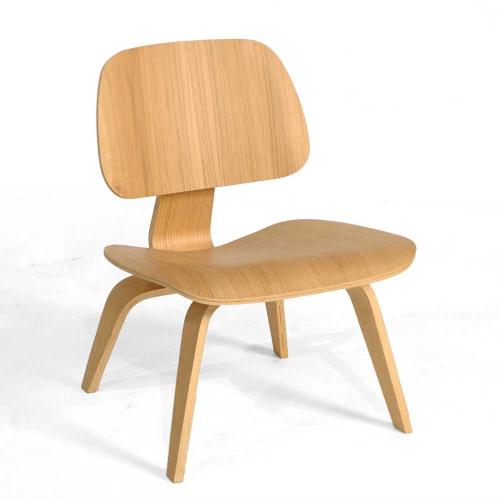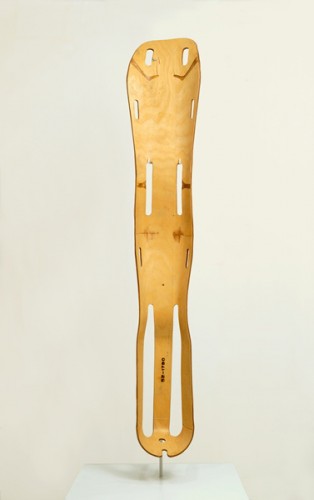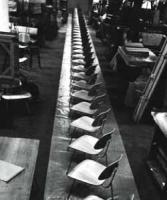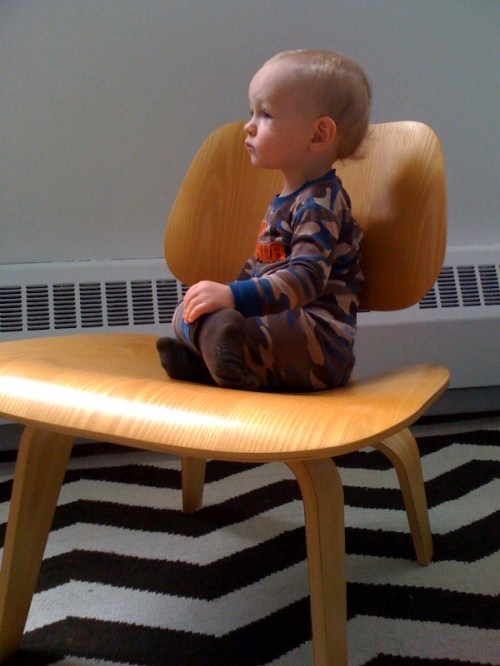The first Chair 101 class is starting, quiet please everyone. Now pay attention because there will be a pop quiz at the end of the series!

LCW in Ash

LCW in Palisander
Today we will be learning about the LCW – Low Chair Wood by Charles and Ray Eames. In my opinion this is the most iconic chair and a great place to start this series. Besides it being first in my personal collection, its my favorite and there are rules to even sit in it at my house: no eating, drinking or writing (seriously, its my baby)! The LCW chair works just about anywhere—from homes and offices to schools and public areas. It continues to be an icon of Modern Design and is valued for its comfort as well as a status symbol. The Eames Molded Plywood Lounge Chair (1946) has been referred to as the “most famous chair of the century” and was hailed “Design of the Century” in 1999 by Time Magazine.

Ray and Charles Eames
During the postwar Good Design movement husband and wife team, often just refered to as The Eames, sought to create inexpensive, comfortable, and modern furniture that could be mass-produced and consistently used plywood in their work. They have been a huge name in the design world since then, 70+ years later. Many of my future lessons will feature Eames designed chairs. The LCW was not a one hit wonder for them but it was the chair that started them all.

Eames Plywood Leg Splint
In 1937, Charles had become head of the department of experimental design at Cranbrook Academy in Michigan and worked with friend and architect Eero Saarinen (you’ll hear more about him in future lessons!) investigating plastics and furniture. The original concept for the molded plywood chairs was conceived in 1940 when Charles and Eero entered a line of furniture into an “Organic Furniture Competition” held by the Museum of Modern Art. They won the competition but production of the initially designed chairs was canceled due to America entering WWII. Charles continued on with plywood experiments and was awarded a contact with the US Air Force for Plywood molded leg splints. It was this same technology that he used to create the LCW in 1946. The chairs were manufactured by the Evans Products Company (Eames’ wartime employer) company in California and distrubuted by the Herman Miller Furniture Company in Michigan (another BIG name in the the mid centure furniture movement) In 1949 Herman Miller took over production completely and is still the only licenced manufacture of the chair in the US. Vitra (remember them for later) presently manufactures for Europe.

Production line in California

Furniture Brochure

Sales Catalog

Vintage Ad for LCW
The LCW is composed of plywood made by molding thin sheets of lightweight maple vaneers into gently curved shapes, giving the material a soft and inviting appearance. Its uninterupted smooth form is contributed to the rubber shocks that are glued, not screwed into the backrest and seat. These shock mounts give flexibility to the chair, making it more responsive to the human body. This made the LCW one of the first chair to have a responsive backrest. The molded plywood family has many other chairs and tables that are also still sought after today. The chair has a sister LCM – Low Chair Metal, with metal legs and cousins DCM and DCW, “D” standing for Dining. The dining chair has a narrower seat, longer legs and doesnt slope back as much as the LCW. Have you ever sat in a LCW? It is amazing that a chair without any padding or upholstery can be that darn comfortable. The seat is higher at the knees and reminds me of sitting in an Adirondack chair. There is no lumbar suport but its not needed with the ergonomic placement of the backrest. Its not a really a lounge chair (just wait they did that too) but its definately a chair that you can sit in for a long time.
So what makes bent ply or molded plywood a good material choice? The cross grain lamination technique create sheets of wood that are extradordinarily strong and can perform in ways that natural solid woods cannot. In the forward of
Bent Plywood by Dung Ngo & Eric Pfeiffer, (a book I gave my husband that actually has a plywood cover) Rob Forbes, founder of Design Within Reach, speaks of plywood furniture (and an Eames leg splint and LCW is pictured), “The very heart of modernism is embodied by the processes that evolved from this combination of human art and industrial woodforming technology, and we have made it the heart of our business”.

Starbucks art

BR ad September 2006 in Dwell mag

Martha Stewart Living featuring LCW
Being an icon nearly since its introduction you can only imagine how many are around. Chances are that you have run across this little chair a few times and didn’t even know it. A few years ago it was on wall murals and art work of every Starbucks. It is constantly used by stylists in magazine articles and in store displays. The LCM is in all fitting rooms in the Gaps in Manhattan and I often see it in window displays at Banana Republic (sorry Old Navy its out of your price range) In doing my research I remembered this BR ad that I had from a Dwell magazine in 2006, it’s so important they made the model get out of her seat for the picture, ha!

MoMa exhibit archives

Macy seeing "mommy's chair" at the Mint Museum in Charlotte, NC
It’s on the permenant collection of the MoMA and I don’t doubt in countless other museums (I know it was in the Mint Museum in Charlotte,NC) My daughter takes great pride when we run across it and always says “Mommy its your chair!”

Eames Chair coasters from MoMA

Inhabit pillow
There are also many products that pay homage to is famous form. I have the Eames chair coaster from the MoMA store which feature 4 of their famous chairs, the LCM being one of them. If you see a book or poster graphically featuring famous chairs it is never left out and Inhabit makes awesome pillows featuring mid-century chair silhouettes.

Molded Plywood Order Form
According to this order sheet, the original price of the LCW was $20.95!! I did a little searching and the vintage ad pictured above from 1952 the prices went up to $25. DWR currently sales the LCW in one of its 4 basic colors for $780, in 2008 it was $650 and 2007, $630. When I bought mine in 2006 it was $600! Wow that’s a price increase of 30% in just 5 years! My history of furniture teacher in design school gave us some wise advice: “Don’t buy fancy cars, invest in furniture”, now I really know what he means! Of course if you really want to have this chair but don’t have the space or quite enough cash for it you can buy it in a scaled down miniature at 4.5 inches tall and $200 from Vitra. But for that price, I think that you might as well save up a little more money for the real thing.

My living room

Hudson enjoys relaxing in the LCW!
Lastly, my beloved little chair may live by a lot of rules in my house but that doesn’t mean its off limits. I believe that you should teach children to respect furniture no matter its cost or design status. Hudson has found the LCW to be a perfect chair to lounge in while he’s watching Yo Gabba Gabba!
Thanks for joining me! Tune in again next week to learn about: the Barcelona chair
Thanks to Avital Gertner for contributing her flickr photo of the starbucks art.
Informational links:
http://www.eamesoffice.com/
http://www.hermanmiller.com/
http://www.industrialdesignhistory.com/
Filed under Chairs 101, NBID



















I love your blog! I’m 44 and I grew-up with all this fantastic furniture my parents started collecting in the early 50s. I’ve been given some of what they have to start my own collecting. They’re both in their early 80s and the furniture in their home is so well-made and it’s still used to this very day. Amazing, considering they had 5 boys and all of the grand/great grand-children are all over it! My gem in my own collection is a Miller/Eames/Evans LCW my parents gave me when I went off to college in 1987. It still looks lovely! Again, terrific info on your blog. Thanks!
Thank you David! As you can tell Im really in love with Eames too, this post took me a long time to write. I think its nearly research paper ready! Im sure theres a fantastic book somewhere with all kinds of tidbits of info that I never found on the internet. If you ever see one please send the name my way, I love the backstories of furniture history. Have you thought about finding out the value of your LCW? I know that the retail price of them has nearly doubled since I got mine so Im sure my used one is in good resale shape. Can you imagine them selling for $25 60 years ago! My hope is that my furniture investment today are not made in vain and that my children will appreciate all the quality they will inherit too!
NB